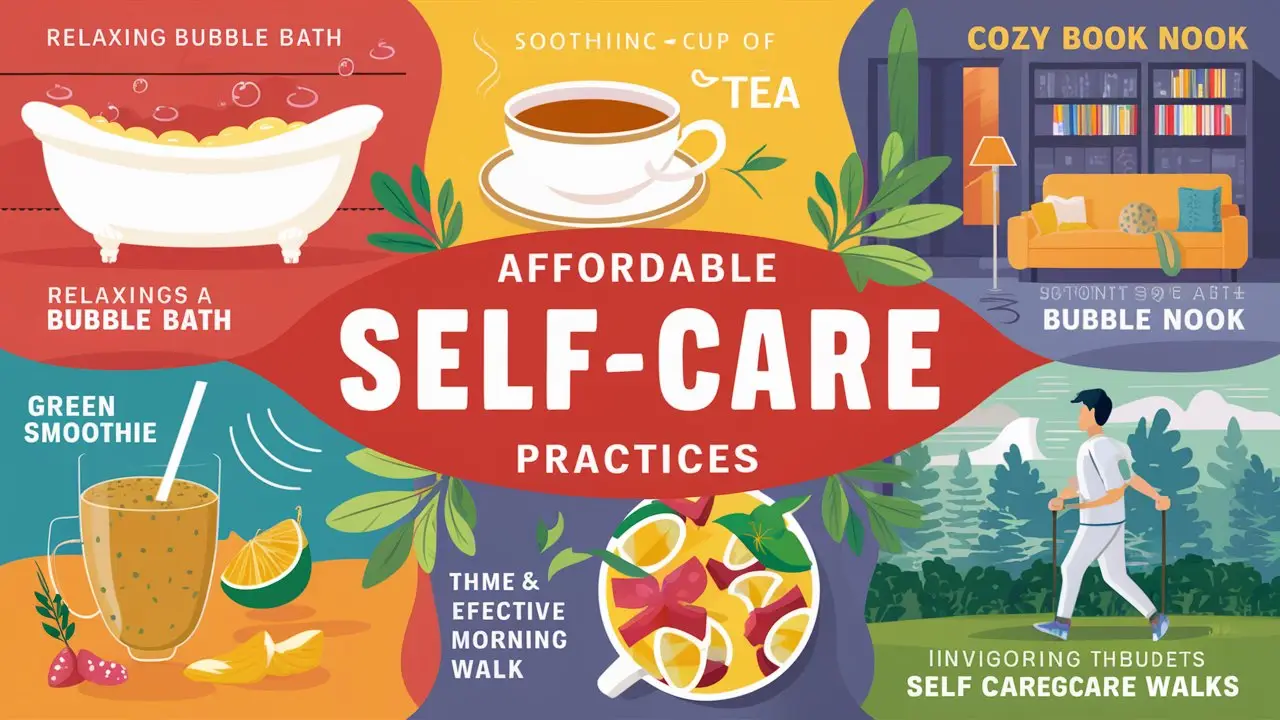Learn how to create a budget-friendly wellness plan with our comprehensive guide.
Creating a wellness plan(How to Make a Budget-Friendly Wellness Plan) that fits your budget can seem daunting, but it’s entirely possible with some careful planning and creativity. In this guide, we’ll explore various ways to maintain a healthy lifestyle without breaking the bank. From affordable fitness routines to cost-effective nutrition tips, you’ll find everything you need to embark on your wellness journey. Let’s dive into how to make a budget-friendly wellness plan that works for you.

Understanding the Importance of a Wellness Plan
A wellness plan (How to Make a Budget-Friendly Wellness Plan) is crucial for maintaining a balanced and healthy life. It encompasses physical, mental, and emotional health, ensuring that you are taking care of your overall well-being. A well-structured wellness plan can help you manage stress, improve your fitness, and boost your overall happiness. The key is to tailor the plan to your specific needs and budget.
Setting Realistic Wellness Goals
When creating your wellness plan(How to Make a Budget-Friendly Wellness Plan), start by setting realistic goals. It’s important to have a clear vision of what you want to achieve. Whether it’s losing weight, improving mental health, or increasing your fitness levels, having specific, measurable, achievable, relevant, and time-bound (SMART) goals will guide your efforts and keep you motivated.
Assessing Your Current Health and Wellness Status
Before you begin(How to Make a Budget-Friendly Wellness Plan), take stock of your current health and wellness status. This includes understanding your physical health, dietary habits, stress levels, and any existing medical conditions. You can do this through self-assessment tools, health apps, or by consulting with a healthcare professional. Knowing your starting point will help you create a plan that addresses your specific needs.

Finding Affordable Fitness Options
- Home Workouts: One of the most budget-friendly ways to stay fit is by exercising at home. You don’t need expensive gym memberships or fancy equipment. There are countless free resources available online, including workout videos, fitness apps, and social media fitness challenges. Bodyweight exercises like push-ups, squats, and lunges are highly effective and require no equipment.
- Outdoor Activities: Nature offers a free and refreshing way to get your daily dose of exercise. Walking, jogging, hiking, and cycling are excellent options. Parks and community centers often have free or low-cost fitness classes, outdoor gyms, and trails that you can utilize. Participating in local sports leagues or joining a community fitness group can also be a fun and affordable way to stay active.
- Discounted Gym Memberships: If you prefer working out in a gym, look for discounts and deals. Many gyms offer off-peak memberships at reduced rates. Check for local community centers or nonprofit organizations that provide affordable access to fitness facilities. Some employers also offer gym membership discounts as part of their employee wellness programs.
Budget-Friendly Nutrition
- Planning and Preparing Meals: Eating healthy doesn’t have to be expensive. Planning your meals in advance and preparing them at home can save you a lot of money. Create a weekly meal plan, make a shopping list, and stick to it. Batch cooking and using leftovers creatively can also reduce food waste and lower your grocery bills.
- Buying in Bulk: Buying staple foods like grains, beans, and nuts in bulk can significantly cut costs. Look for bulk bins at your local grocery store or consider joining a wholesale club. These items have a long shelf life and can be used in a variety of meals, making them a cost-effective choice.
- Seasonal and Local Produce: Fruits and vegetables that are in season are generally cheaper and fresher. Visit local farmers’ markets to find affordable and high-quality produce. Community-supported agriculture (CSA) programs are another great way to get fresh, local produce at a lower cost. Not only does this support local farmers, but it also reduces the carbon footprint associated with transporting food.
- Reducing Food Waste: Being mindful of food waste is not only good for your wallet but also for the environment. Use up what you have before buying more, and get creative with leftovers. Store food properly to extend its shelf life and consider composting food scraps to reduce waste.
Affordable Mental Health Strategies
- Mindfulness and Meditation: Practicing mindfulness and meditation can greatly improve your mental well-being and reduce stress. These practices can be done for free at home using online resources, apps, or books. Dedicate a few minutes each day to sit quietly, focus on your breath, and clear your mind. Over time, this can lead to significant improvements in mental clarity and emotional stability.
- Journaling: Keeping a journal is a simple and inexpensive way to manage stress and improve mental health. Writing down your thoughts, feelings, and experiences can help you process emotions and gain insights into your behavior and mindset. Journaling can be done with a basic notebook and pen, making it a budget-friendly mental health tool.
- Connecting with Others: Social connections are vital for mental health. Surround yourself with supportive friends and family members. Participate in community events, volunteer, or join clubs that align with your interests. These activities are often low-cost or free and can provide a sense of belonging and purpose.
- Utilizing Free and Low-Cost Mental Health Resources: Many communities offer free or low-cost mental health services. Look for nonprofit organizations, community centers, and online resources that provide counseling, support groups, and educational materials. Mental health apps can also offer guided meditations, mood tracking, and coping strategies at little to no cost.
Incorporating Wellness into Your Daily Routine
- Prioritizing Sleep: Sleep is a crucial component of overall wellness. Aim for 7-9 hours of quality sleep each night. Establish a bedtime routine that promotes relaxation, such as reading, taking a warm bath, or practicing gentle stretching. Avoid screens and stimulants before bedtime to improve your sleep quality.
- Staying Hydrated: Drinking enough water is essential for maintaining good health. Carry a reusable water bottle with you and make a habit of sipping water throughout the day. This simple practice can improve your energy levels, support digestion, and promote clear skin.
- Balancing Work and Life: Achieving a healthy work-life balance is key to reducing stress and improving overall well-being. Set boundaries between work and personal time, take regular breaks, and make time for activities you enjoy. If you work from home, create a dedicated workspace to separate work from leisure.
Affordable Self-Care Practices
- DIY Spa Treatments: Pampering yourself doesn’t have to be costly. Create a spa-like experience at home with DIY treatments. Use ingredients from your kitchen, such as honey, oats, and avocado, to make face masks, scrubs, and hair treatments. Light some candles, play soothing music, and enjoy a relaxing bath or foot soak.
- Exercise and Stretching: Regular exercise and stretching are vital for physical health and can be done at little to no cost. Incorporate simple exercises like yoga, pilates, or stretching routines into your daily schedule. Many online platforms offer free classes and tutorials to guide you.
- Reading and Learning: Reading books, listening to podcasts, or watching educational videos are excellent ways to relax and expand your knowledge. Libraries offer free access to a vast array of resources, and many e-books and audiobooks are available online for free or at a low cost.
- Creative Hobbies: Engaging in creative activities can be incredibly therapeutic. Whether it’s painting, knitting, gardening, or cooking, find a hobby that brings you joy. Many creative pursuits require minimal investment and provide a great outlet for self-expression and relaxation.
Tracking Your Progress
- Keeping a Wellness Journal: Documenting your wellness journey can help you stay accountable and track your progress. Write down your goals, daily habits, and any changes you notice in your physical or mental health. Reflecting on your entries can provide motivation and insights into what works best for you.
- Using Apps and Tools: Numerous apps are available to help you monitor different aspects of your wellness plan, from fitness and nutrition to sleep and mental health. Many of these apps are free or have low-cost premium versions. Find one that suits your needs and use it consistently to track your progress.
- Celebrating Milestones: Acknowledge and celebrate your achievements, no matter how small they may seem. Reward yourself with non-monetary treats, such as a relaxing day off, a favorite meal, or an outing with friends. Celebrating milestones can boost your motivation and reinforce positive habits.
Adapting and Adjusting Your Plan
- Being Flexible: Life is unpredictable, and your wellness plan should be adaptable. Be open to making changes as needed and don’t be too hard on yourself if things don’t go perfectly. Flexibility is key to maintaining long-term wellness without unnecessary stress.
- Seeking Feedback: Get input from trusted friends, family members, or wellness professionals. They can provide valuable insights and suggestions to improve your plan. Sometimes, an outside perspective can highlight areas you might have overlooked.
- Reviewing and Revising Your Goals: Periodically review your goals and progress. Are your goals still relevant? Have your priorities shifted? Adjust your plan accordingly to ensure it continues to meet your needs and supports your overall well-being.
FAQs
- How can I stay motivated to follow my wellness plan: Staying motivated can be challenging, but setting clear, achievable goals and tracking your progress can help. Celebrate small victories, find a workout buddy, and remind yourself of the benefits you’re gaining. Keeping a wellness journal or using a fitness app can also provide motivation by showing how far you’ve come.
- What are some budget-friendly healthy snack option: Affordable healthy snacks include fresh fruits, vegetables with hummus, nuts, seeds, yogurt, and homemade granola bars. Preparing snacks at home is usually cheaper than buying pre-packaged items and allows you to control the ingredients.
- How can I incorporate wellness practices into a busy schedule: Time management is key. Schedule wellness (How to Make a Budget-Friendly Wellness Plan)activities just like you would any other important appointment. Even small, consistent practices like a 10-minute workout, a quick meditation session, or preparing a healthy meal can make a big difference.
- What are some affordable ways to reduce stress: Affordable stress-reduction methods include practicing mindfulness and meditation, journaling, exercising, spending time in nature, and engaging in hobbies. Utilizing free resources such as online meditation guides, local community events, and support groups can also help.
- Can I maintain a wellness plan while traveling: Yes, you can maintain your wellness plan while traveling by planning ahead. Pack healthy snacks, stay hydrated, find opportunities for physical activity, and make time for relaxation. Many hotels offer fitness facilities, and there are plenty of free online workout videos that can be done in your room.
- How can I involve my family in how to make a budget-friendly wellness plan: Involving your family can make wellness more fun and sustainable. Plan and prepare(How to Make a Budget-Friendly Wellness Plan) healthy meals together, engage in family fitness activities like hiking or biking, and practice mindfulness as a group. Creating a supportive environment makes it easier for everyone to stay on track.
Conclusion
Creating a budget-friendly wellness plan(How to Make a Budget-Friendly Wellness Plan) is not only possible but also rewarding. By setting realistic goals, utilizing affordable resources, and incorporating wellness practices into your daily routine, you can achieve a balanced and healthy lifestyle without breaking the bank. Remember, the key is consistency and flexibility. Adapt your plan(How to Make a Budget-Friendly Wellness Plan) as needed, celebrate your progress, and continue to prioritize your well-being. With determination and creativity, you can thrive on a budget and enjoy the benefits of a holistic wellness plan.
50/30/20 Rule Spreadsheet: Easy Money Management
By following these strategies (How to Make a Budget-Friendly Wellness Plan), you’ll be well on your way to maintaining a healthy and fulfilling lifestyle without overspending. Embrace the journey and enjoy the positive changes in your life!
For more information regarding Finance Basic you can visit FinancewithAi Channel & Home
Unifin Debt Collector: The Ultimate Guide to Your Rights 101
Debt Verification Letter – Protect Your Rights Now 101
Master Corporate Debt Restructuring: Strategies, Benefits, and Challenges 101
Save More with Automated Savings Strategies 101


Pingback: Long-Term Goals: Building a Secure Financial Future 101 Goals